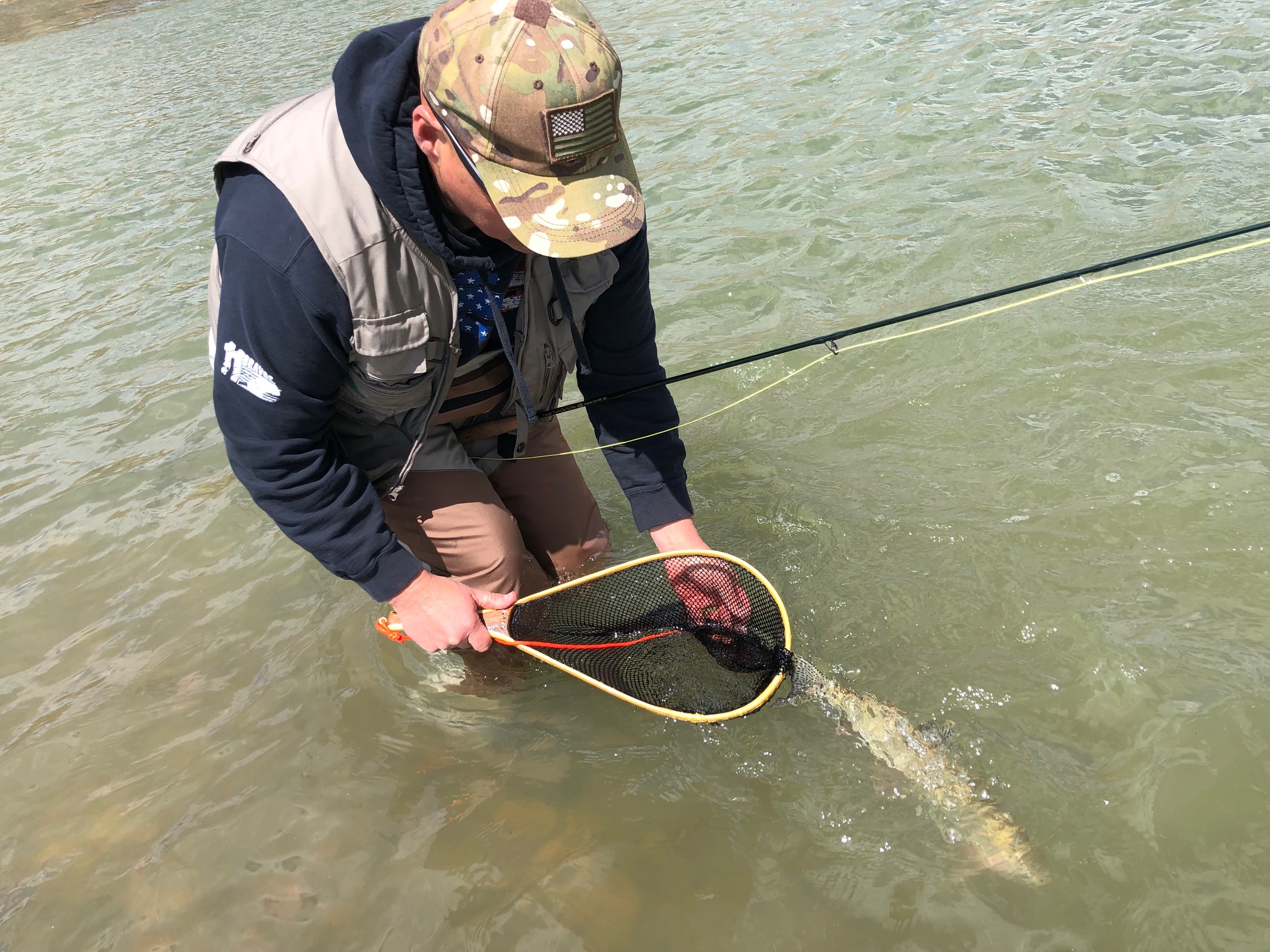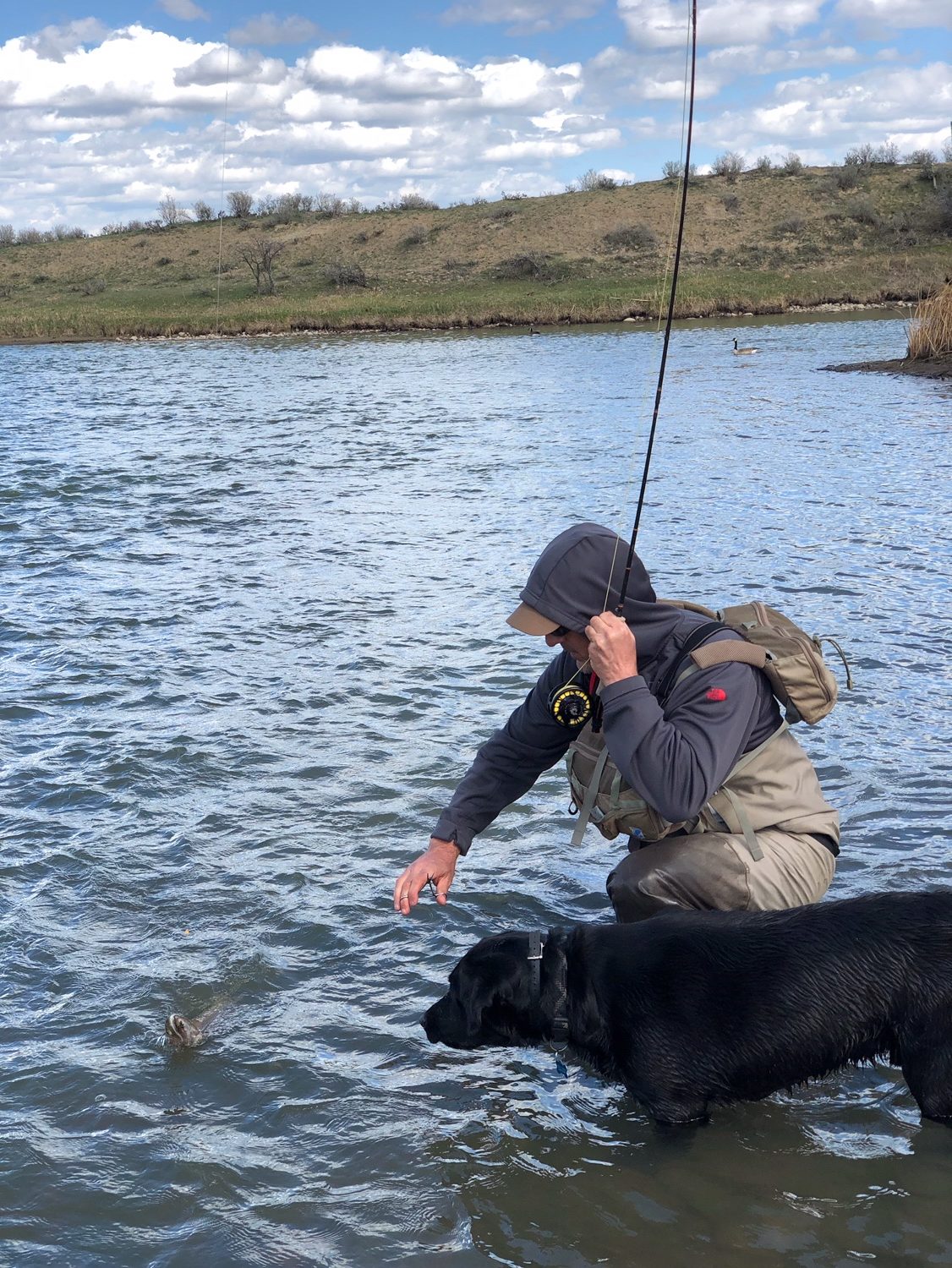Between the raw spring snowstorms, and the brilliant sunny days that make you believe winter has retreated for good, I received a phone call from a friend in Sheridan. Mark is one of the few people I’ve met through writing. He and his group of bird hunters saw an article I wrote for Wyoming Wildlife, and emailed me to see if I wanted to tag along. Last season, I drove up to Johnson County, and Mark showed me some of the public lands and walk-in areas where he and his group likes to chase birds. We all shot poorly. A few excursions to the Occidental Saloon in Buffalo, and we were becoming fast friends, planning future hunts and exchanging our misbegotten philosophy about bird dogs, college football, and public lands. Mark, a fellow Virginian, talked about wanting to get into fly fishing. Like me, his first encounters with trout were painful excursions into the Blue Ridge Mountains, where most of the fish were put-and-takes raised on protein pellets at the nearby fish hatchery. Now that he had finally made it to Wyoming, he wanted to purchase a fly rod, learn to tie flies, and catch the wild trout for which the West is famous.
I’ll fish with nearly anyone. I sort of prefer the newbies over the pros. With the inexperienced guys I can be of some use, and I can pass myself off as a competent fly fisherman. With the beginners you get to experience a new the thrill of catching a two-pound fish. And you don’t have to listen to prolonged narratives about fishing from helicopters in Kamchatka, or casting to tarpon in Isla Holbox. I told Mark that I’d love to take him, but we had to pick the right day. And then I discovered that he had no waders and wanted to see if he could fish from the bank.

“I got some rubber boots and some sweatpants,” he said. I was mortified. Here I had to draw the line. I told him that the water temperatures were in the low forties and he wouldn’t last ten minutes in wet boots and pants. Besides, the current would sweep him downstream, or rip his sweatpants off and send them to Nebraska. Being a known member of the local fly-fishing community, I could not afford to be seen with a half-naked, fifty-year-old man on the chalky banks of my home water. I persuaded him into buying a pair of waders before he came to town.
“You’ll use them your whole life,” I said, “Or at least until they spring a leak.”
And I gave him a list of other things too: red rock worms, BB split shot, indicators, and a dozen bead head hare’s ears. Sunblock. Gloves. Snacks appropriate for middle-aged men. A pair of forceps you don’t mind losing.
“Oh, and get some copper johns, or brassies,” I added. “Get them in size sixteen.”
Mark arrived in town just as I was finishing up my last class of the day. I took him to some of the public access areas enmeshed in sage and cottonwoods, places where you find the sooty remnants of fire rings. Bates Creek was pumping mud, so the lower river was a no-go. We poked around and decided to fish just upstream of Bates. There were no boats, no fishermen standing in the likely spots. We bumped over the two-track roads and threw up a trail of dust. Soon we were rigging up. I showed him how to attach his leader, how to affix the indicator, and how to tie a dropper off the lead fly. He was a quick learner and wanted to do things for himself. He had a rudimentary fly box full of the basics. He told me that he had enrolled in a fly tying class in Sheridan, and the fly box was full of his own efforts. They looked like flies I buy at the fly shop.
The advice to purchase waders proved to be a good one. By wading out to the gravel bars and casting back towards shore, Mark did not have to worry about losing his flies on the back cast to willows, reeds, and ancient barbed wire. I showed him how to use the friction of the river to make a roll cast. I told him that it didn’t really matter how far he could cast; often, the trout are right at your feet. I said something about how, what really matters is getting a drag-free drift, making your flies tumble downstream as if they are untethered insects that have been washed into the flow.
Just then, Mark’s indicator blurred and shot across the river.
“Fish on!” he hollered, his Virginia twang reminding me of the guys I knew back in Blacksburg, when we were all trying to survive a semester that seemed unending, cafeteria food, professors that appeared like ether at the podium.

I could tell by the way the indicator blew upstream that Mark had a large fish. The line spun from his reel. We had never taken a serious look at the drag system on his new purchase. He was losing lots of line. The fly line sliced through the current. Just then I saw Mark reach forward and grab his fly line. I supposed he thought the fish was getting away, and by grabbing the line he could stop it. It’s an impulse that can only end in disaster. Of course, the line snapped: yard sale. I told him not to feel bad, that I did the same thing years ago. We got him rigged up, and for the rest of the day we were delighted by those fourteen to sixteen inch fish that you’d swear are so much bigger when you first come tight. I saw him catch and release his first trout without any coaching from me.
“Man, I would have liked to have seen that big fish,” said Mark. He kept thinking about the one that broke off, as we all do. I told him that, in fly fishing, letting go is the main thing. Let go of your money; let go of your career plans; let go of having the best-looking yard on the block. Let, as I do, your dogs go freely along the banks. Cast away your dreams of being Employee of the Month. Cast away your ideas about normalcy and being reliable in the world of deadlines and end-of-the-year reports.
“No one reads those anyway,” I said.
And for once, and only for a few hours, I was right about something. The copper johns and brassies were on fire. All you had to do is get a decent upstream cast, let the flies sink in the current and hold on. The fish were suspended mid-current, snatching the flies as they drifted in the murky riffle. I could see, emerging from the gravel bar, the type of fly fisherman Mark was going to be: determined, but not overzealous. I showed him how to wet his hands before he handled a fish. I showed him how to revive them a bit in the net. How to hold them light lightly in your hands as they recover. He was careful with all of the fish he caught. He was doing it all by himself as the day ended. I gave him plenty of room as he landed the last fish of the day, removed the fly, and let it fade out of the net.




